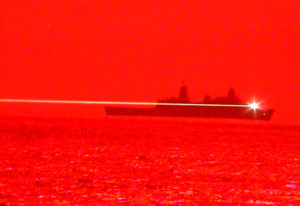The Navy last week successfully shot down an unmanned aerial vehicle (UAV) using a laser weapon installed on the USS Portland (LPD-27) San Antonio-class amphibious transport dock.
The service said LPD-27 conducted the test of its Solid State Laser – Technology Maturation (SSL-TM) Laser Weapons System Demonstrator (LWSD) MK 2 MOD 0, which “successfully disabled an unmanned aerial vehicle (UAV)” on May 16 while operating off Pearl Harbor, Hawaii.

“By conducting advanced at sea tests against UAVs and small crafts, we will gain valuable information on the capabilities of the Solid State Laser Weapons System Demonstrator against potential threats,” Capt. Karrey Sanders, commanding officer of Portland, said in a statement.
Sanders added that this demonstration “is a unique capability the Portland gets to test and operate for the Navy, while paving the way for future weapons systems. With this new advanced capability, we are redefining war at sea for the Navy.”
The Navy first announced the Portland would get this weapon in 2018. The system is fitted into what was originally reserved for the Vertical Launch System (Defense Daily, Jan. 10, 2018).
LWSD was developed by the Office of Naval Research (ONR) and was installed on the ship for the at-sea demonstration. ONR also provided power modules to control the laser that the Navy previously said would fit in the open and reserve weight spaces.
LWSD is a next-generation follow-on to the earlier 30-kilowatt (kW) Laser Weapons System (LaWS) that was tested on the USS Ponce for three years while it served in the Middle East. Ponce tested its laser system against UAVs and small boats (Defense Daily, March 29, 2017).
#USSPortland (LPD 27) conducts Laser Weapon System Demonstrator Test in Pacific: https://t.co/zZJglgDIcf @USNavy @USNavyResearch #NavyLethality pic.twitter.com/K8xtcEWiRz
— U.S. Pacific Fleet (@USPacificFleet) May 22, 2020
The Navy expects to eventually transition the SSL-TM from LaWS and LWSD up to a 150-kilowatt laser weapon, using lessons learned from the various demonstrations.
The Navy underscored the operational employment of the LWSD on a Pacific Fleet ships is the “first system-level implementation of a high-energy class solid-state laser.”
The system was developed for the Navy by
Northrop Grumman [NOC] with full system and ship integration and testing led by Naval Surface Warfare Centers Dahlgren and Port Hueneme.
When the Portland testing was first announced, Capt. Brian Metcalf, program manager for the LPD-17, said he did not know how long the laser system would be fielded on the ship, but noted nobody expected the LaWS to serve on Ponce for three years.
“The Solid State Laser Weapons System Demonstrator is a unique capability the Portland gets to test and operate for the Navy, while paving the way for future weapons systems,” Sanders added.
This system is not the only laser system the Navy is testing and planning to install on ships.
In March, ONR awarded Lockheed Martin [LMT] a $22 million contract to demonstrate and test a Layered Laser Defense prototype weapon system on a Littoral Combat Ship while it is underway. The Navy previously planned to install a 150-kW laser weapon from the company on the USS Little Rock (LCS-9) this year as well (Defense Daily, March 16).
Separately, the Navy plans to install the first 60-kW Lockheed Martin High Energy Laser and Integrated Optical-dazzler with Surveillance (HELIOS) directed energy system on the USS Preble (DDG-88) DDG-51 Flight IIA destroyer by FY 2021 (Defense Daily, March 20, 2019).
In February, the service had installed the first Optical Dazzling Interdictor, Navy (ODIN) counter-UAV system on the USS Dewey (DDG-105) during its last dry-docking selected restricted availability.